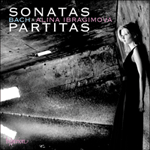Bach’s set of unaccompanied violin music begins with the Sonata in G minor (BWV1001). Its richly ornamented opening Adagio is both harmonically and expressively wide ranging, taking us far from the home key in the first half of the movement. The Fuga which follows is concisely argued, its densely worked theme almost ever present and discernible throughout. It was later transcribed, perhaps by Bach, for solo organ and for lute solo. The Siciliana, in which three voices are sustained, has something of the character of a trio sonata movement. This technically demanding piece contains intriguing implication and ambiguity for the listener. The Sonata concludes with a lively Presto whose sixteenth-note passagework, chordal figurations and technical virtuosity lend brilliance to its character.
from notes by Nicholas Anderson © 2009
Le recueil de musique pour violon seul de Bach commence par la Sonate en sol mineur (BWV1001). Son Adagio initial richement ornementé est d’une portée considérable tant sur le plan harmonique qu’expressif; il nous emmène loin de la tonalité d’origine dans la première moitié du mouvement. La Fuga qui suit est concise, son thème très travaillé est presque toujours présent et perceptible d’un bout à l’autre. Par la suite, cette Fuga a été transcrite, peut-être par Bach, pour orgue seul et pour luth seul. Le Siciliana, dans lequel trois voix sont soutenues, a un peu le caractère d’un mouvement de sonate en trio. Cette pièce difficile sur le plan technique recèle une implication et une ambiguïté intrigantes pour l’auditeur. La sonate s’achève sur un Presto animé, dont les traits en doubles croches, les figurations en accords et la virtuosité technique donnent de l’éclat à son caractère.
extrait des notes rédigées par Nicholas Anderson © 2009
Français: Marie-Stella Pâris
Bachs Werkezyklus für Violine solo beginnt mit der Sonate in g-Moll (BWV 1001). Der reich verzierte erste Satz, Adagio, ist sowohl expressiv als auch harmonisch weitgespannt und entfernt sich deutlich von der Grundtonart der ersten Hälfte des Satzes. Die darauffolgende Fuga ist präzis konzipiert und das dicht gearbeitete Thema ist fast durchgehend gegenwärtig und wahrnehmbar. Sie wurde später, möglicherweise von Bach selbst, für Orgel solo und Laute solo umgeschrieben. Das durchgehend dreistimmige Siciliana erinnert im Charakter an einen Triosonatensatz. Dieses technisch anspruchsvolle Stück stellt den Hörer vor faszinierende Verwicklungen und Mehrdeutigkeiten. Die Sonate endet mit einem lebhaften und technisch virtuosen Presto mit brillanten Sechzehntelpassagen und akkordischen Figurationen.
aus dem Begleittext von Nicholas Anderson © 2009
Deutsch: Viola Scheffel


 Bach: Sonatas and Partitas for solo violin
Bach: Sonatas and Partitas for solo violin
